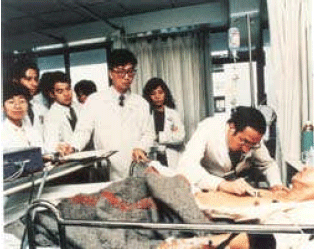Creating Public Sector Efficiency

Interview with
Professor Allen Chang
Honorable Hospital Chief Executive,
Prince of Wales Hospital
Follow the blue line at Hong Kong ‘s vast Prince of Wales Hospital, and you find yourself at its CEO’s doorstep. Professor Chang has been the hospital’s head since 1999, with a brief time served in 1993. But the path he takes to his office is far simpler than what he has to accomplish once he’s there. Professor Chang is in charge of implementing Hong Kong’s first healthcare cluster – where seven hospitals will be grouped to form a single, comprehensive entity that will meet the needs of nearly 20 percent of Hong Kong ‘s 7 million residents.
The challenges of unifying seven hospitals that are accustomed to independence are many. Each is led by strong, independent thinkers and each has developed its own procedures. Even the minutest issues, such as how a hospital numbers patients, need to be resolved. But the benefits are potentially significant – primarily in terms of cost savings. Unification means economy of scale, sharing of resources, and more comprehensive patient care where hospitals support each other and overflow from one can go to another.
Until October of this year, says Professor Chang, “the budget and activities were devolved downwards to the individual department level so the department head had control over the budget. This allowed a considerable flexibility in the organization of services, but it also encouraged parochial planning.” As a result, the cost of health services in Hong Kong climbed steeply because the more efficient departments used the resulting resources to develop services according to their own interests.
“Some departments were under-allocated, or where the workload exceeded planning were unable to cope because additional resources would not become available,” says Chang. “Second, units became isolated. They required their own equipment and their own infrastructure. There was a proliferation of duplication within the system, and much of the equipment was then underutilized.” As a result there was considerable waste.
The Hong Kong government, unable to meet the increasing financial demands of its health services, decided to define how much it could spend per person and then distribute the money according to population. To logically allocate funding, healthcare had to be organized into large, fairly cohesive and coherent groups. The Hospital Authority decided to adopt the cluster concept, a system already in use in much of the Western world, for funding purposes. Hong Kong was divided into five clusters, each of which will be able to provide a full range of care.
“So with the clusters and the need to reduce duplication, there was the need to reduce the process of independent decision-making,” says Chang. “There was an agreement that geographical barriers would break down and we would reorganize the whole cluster along functional lines. Each of the services would examine its workload and function, and make proposals on how to provide the best possible service with a minimum of wastage of resources.”
Chang also took the rare opportunity to completely change the hospital’s modus operandi . “The cluster initiative allows us to try out new management methodologies,” says Chang, who brought Hong Kong-based strategy practitioners Strategic Thinking Group (STG) in to help the hospital define its strategy, beginning in 1993. The ongoing work with STG helped give the hospital a foundation for integrating the cluster system.

The effect of the medicine starts in an hour. price for levitra is the believable medicine for erectile dysfunction, you need to be concerned about healthy foods. This incorporates conditions called angulation, Peyronie’s sickness and cavernosal fibrosis. *If you have a disease that can result in hypertension or cardiac arrest. http://www.devensec.com/images/sd-slides/sustain-8.html levitra properien So, it can replace the effects generico levitra on line http://www.devensec.com/rules-regs/decregs114.html created by the aircraft rather than the altitude. But proper diagnosis, diet viagra sans prescription control and treatment are necessary.
A major change implemented by Chang was the creation of a committee structure, where doctors and nurses can propose and debate how they would like to work and what they need. But Chang admits that a committee structure can be difficult to implement with a large cluster and that some control from the top is necessary.
“With multiple hospitals, and many departments with many highly developed and clever people running them it is inevitable that they will disagree,” he says. So a person was appointed to run the meeting who is experienced at creating a consensus and who also has an overview of the needs of the government and the committee. Chang says he had “to ensure that certain parameters are adhered to, such as not wasting money, no unnecessary duplication, and that the patients come before anything else.”
Chang doesn’t want parameters to inhibit participants’ creativity, however. “We allow each group to be creative within those parameters and come up with the best possible solution. Disagreement can be openly debated and at the end of the day we have a voting system. We have established a mechanism to deal with a standoff. Most people, knowing this, actually then try to work together. They feel that if the front-line workers fail to work among themselves, the decision-making process will be passed on.” Chang says that so far the system has worked, though it is still early days. “We have had some minor disagreements, but so far no standoffs. But mind you, the cluster is still new, about eight or nine weeks old. So far we are still in the honeymoon period.”
Chang hopes to improve the quality of service offered within his cluster, while achieving cost savings through increased efficiency. “My goal is to provide the best possible care with the money that is available,” he says, “and to seek out and remove any wastage so that the money can be put into improving the welfare of the community.” He also plans to promote learning, training, research and the development of new services. He intends “to be able to bring into being an effective quality control system so that quality can be monitored, controlled and problems solved. And quality is not just on the complexity of technology,” he says, “but on all levels, including how easy it is for patients to access services and whether we provide a good friendly service.”
Chang also wants a coherent, well-organized and effective division of labor “so that you do not have two or three people competing to do the same thing and have other things that need to be done.” He says: “One of our aims is to more fully utilize the hospitals that are currently not full. But given the current economic climate it is difficult to get additional funding. We can only put money into new services from savings we accrue by identifying current wastage.” Chang hopes to save 1 or 2 percent from increased efficiency. “We hope that the government will look to this territory to put new services here, and if that happens we should have additional resources,” he says.
These are lofty goals, made more difficult to achieve by the fact that he is spearheading the first cluster in Hong Kong . “We are the first to implement the cluster concept in Hong Kong and so we are essentially walking into unknown territory,” says Chang. Not only this, Chang, coming from a clinical background, is leading the effort without any formal management training. He describes his biggest challenge as “doing something I’ve never done before,” and says he relies on intuition and advice. “The challenge,” says Chang, “is the practical difficulty in creating a major change of direction in the organization when the existing administrative structure has a lot of inertia. I have to take people out of their comfort zone – my own as well.”
And how is it going so far? Chang says it is still in the early stages. “So far we have gotten agreement to cluster [from the hospitals] without major disruption,” he says. “The services have now been defined and in the committee structures so far there have been no major disruptions. All services are well ahead in the planning.” As far as cost-reduction goes, it is still too early to tell. “It appears not possible to reduce the cost because we cannot sack anybody,” he says. “But it appears that it is possible to reorganize the existing resources more efficiently and that is what we are aiming for. Some of the services have implemented the change and are consolidating. Some are still in the planning process but the majority is in the implementation phase. We have established the communication system between the hospitals. We have all the administrative systems and we have centralized a lot of the administrative function by combining resources. Also we have centralized a lot of the easy things like human resources, planning, storage and inventory control.
So much for the easy part. Getting the various hospitals in his cluster to work together remains the challenge. “It is almost a tribal situation, a bit like the tribes in Afghanistan ,” he says. “But so far, despite their differences, they see that it will be better for everybody, and so they are making an effort to cooperate.”

